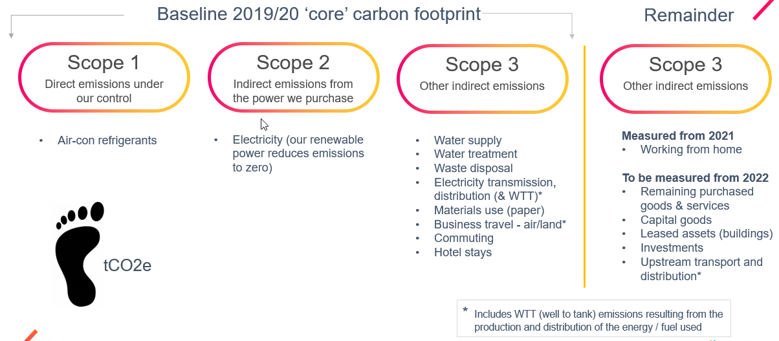Our Climate Pledge - Hymans Robertson's response to the climate crisis - was launched in early 2021, committing us to halving our measured carbon emissions by 2025. We also pledged to use carbon off-setting to reach a ‘net zero’ position each year, to tackle our historic carbon footprint and to ensure that climate risk is fully incorporated in both our client services and the way that we run the firm. So, 18 months later - how are we faring?
Well, in a nutshell - it’s been eventful, we’re making good progress and we’ve learned a lot. Here’s the story so far.
Eventful times
The covid-19 pandemic impacted everyone and every organisation, and of course we were no exception. Our baseline year for our carbon calculations is 2019/20 – when our core footprint totalled 1988 tCO2e and a significant majority of our emissions could be attributed to business travel (particularly by air) and the electricity used in our offices.
Yet the following twelve months saw our offices closed and everyone working at home for most of the year, and so virtually no business travel or commuting taking place. Add in the emission savings of our implementation of 100% renewable energy across our 4 office locations and our like-for-like core carbon footprint for 2020/21 totalled just 100 tonnes, far below even our 2025 target of 994 tonnes (50% of our 2019/20 figure).
And the disruption and travel restrictions impacted much of 2021/22. We’ll have our carbon footprint for this period finalised very shortly (and will update this article as soon as it’s confirmed), but we already know it will still be abnormally low. That means that it will be the end of this financial year in March 2023 before we have a ‘new normal’ set of emissions data to assess alongside our baseline numbers - and can work out exactly what’s left to do to meet our Pledge commitment.
Reducing our emissions – travelling less, and travelling smarter
Business travel formed almost 55% of our 2019/20 baseline carbon footprint, yet ground to a halt with the pandemic. A rare positive of an otherwise horrendous period was how video technology enabled us to carry on communicating and working effectively with clients - and each other - despite all the disruption.
Face-to-face interaction will always be vitally important to the way that we work, and we’ve embraced its return. However, we’ve also embraced the benefits of more frequent, informal communication by video, the wellbeing benefits of less business travel and of course, the positive environmental impact. Our challenge moving forward is to get the balance right and keep our travel emissions at an acceptable level. To help do that we’ve taken several significant measures.
-
Our travel & expenses policy and accompanying guidance has been overhauled to highlight our climate pledge commitments and encourage everyone to ‘Travel less, travel smarter’.
-
We’ve made sure our people and our clients are on board with our climate commitments.
-
Travelling less has seen a widespread reduction in the frequency of business trips, while travelling smarter is about being mindful of the impact of the travel that we do undertake.
That means better planning to maximise the value of each trip (and reduce the need for further travel) and considering how we make the journey. For example, did you know that taking the train between Scotland and London instead of a flight, reduces the emissions of the trip by more than 75%?
-
We’ve worked with our travel provider to optimise our booking platform to highlight the carbon footprint of every trip, and provide prompts to suggest more environmentally friendly options when journeys are being planned.
-
And we challenged our business units and client teams to review how they travel and commit to reducing emissions going forward. Adding those commitments together gives us a projected decrease of c60% in internal travel emissions, a hugely positive start that we’re now seeing play out in reality in our monthly travel emission reports.
Carbon off-setting - strong progress
We’re clear that reducing our carbon emissions is the most effective climate measure we can take, but we’re also committed to off-setting our measured and lifetime emissions to achieve a net zero position. We’ve done that each year using Gold Standard and Verified Carbon Standard off-setting schemes to ensure that the carbon reduction is real, permanent and fully verified – and are more than two-thirds of the way to off-setting our estimated 33,800 tCO2e lifetime footprint.




